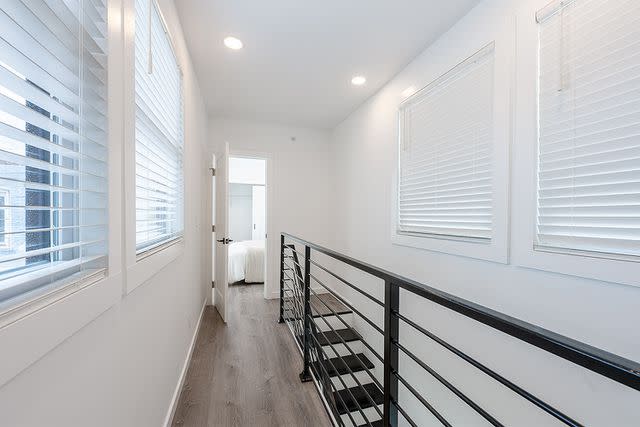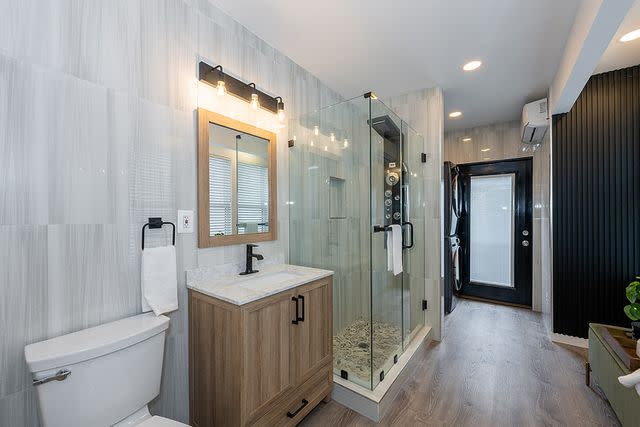6-Foot-Wide 'Skinny Home' Hits the Market for Under $600K in Washington, D.C.: Look Inside (Exclusive)
"The biggest accomplishment is that we made every use of that space down to the centimeter," contractor Nady Samnang tells PEOPLE

Jennifer Young Homes
the 600-square foot house in Washington, D.C.When contractor Nady Samnang first purchased the small lot at 1738 Glick Ct. NW in Washington, D.C's trendy Shaw neighborhood, he and his brother had planned on building a four-level, 15-foot-wide single-family home.
Samnang, CEO of Virginia contractor Omnifics, said the plans for the home were even approved by the district. But when ground-breaking began, they were promptly issued a stop work order.
"Unbeknownst to us, the city made changes to the zoning laws after we purchased the lot," Samnang tells PEOPLE.
Those changes meant that the brothers were confronted with a major setback: "The zoning laws only allowed for a six-foot blueprint of a house."

Jennifer Young Homes
The exterior of the six-foot wide home"At that point, I spoke to my brother and architect and said, 'Hey, is this even viable? Or possible for someone to live?’ " Samnang says.
The team began brainstorming to ensure any plans would adhere to the city guidelines. Over a year-and-a-half later, the 600-square-foot, six-foot-wide home — recently pegged "the skinniest house in all of D.C." by WTOP News — hit the market.
Samnang admits that the construction process was brutal. Due to the small footprint, no heavy equipment (think cranes or large trucks) could drive on to the property, meaning all of the materials had to be walked up to the project site by hand.

Jennifer Young Homes
the living areaThe small space also meant that only two workers could be on site at all times.
But by using design principles gleaned from their previous experience, Samnang says the home feels much larger than it actually is.

Jennifer Young Homes
The entry to the home"We still did bay windows in every living area — so while the hallway is six-feet across, in the areas in which people would be living, there's 100 square feet of room," he says. "We have high-end cabinets, quartz countertops, wall-to-wall porcelain tiles in the bathroom. That was really important to us: If you’re going to build a very small house, it better be nice."
The home is currently on the market for $599,900.

Jennifer Young Homes
A stairway in the homeSarah Noel — a realtor at Jennifer Young Homes, which is managing the listing — says the ideal buyer would be someone who doesn't need a large footprint and appreciates the ease and convenience of a small space located in a desirable area.
"Not everybody wants a lot of square footage to maintain," Noel says. "That and other factors like interest rates and lending is why you're seeing the tiny house movement become so popular."
As Samnang says, the small space might be unique for a home but in Washington, D.C., it's not all that different from living in a condo.

Jennifer Young Homes
The primary bathroom"The right buyer is going to be that city dweller — someone who doesn't necessarily want a car, since it's one block from a metro station. They don't want condo fees or neighbors, and they don't need a whole lot of space."
Despite the challenges, Samnang says the project is something of a feather in his cap, due to all the constraints he and his team faced from the outset.
"We had zero margin for error," he says. "If we had gotten one thing wrong on the design, everything would have had to be re-done. The biggest accomplishment is that we made every use of that space down to the centimeter to pass code."

Jennifer Young Homes
the bedroom in the homeNever miss a story — sign up for PEOPLE's free daily newsletter to stay up-to-date on the best of what PEOPLE has to offer, from juicy celebrity news to compelling human interest stories.
And though it's something of a showpiece for him now — in that it proves how creative his team can be — that doesn't necessarily mean he's itching to do it again.
"The build itself was not fun at all. My contractors probably cussed me out every week. It was a nightmare," he admits.
For more People news, make sure to sign up for our newsletter!
Read the original article on People.


